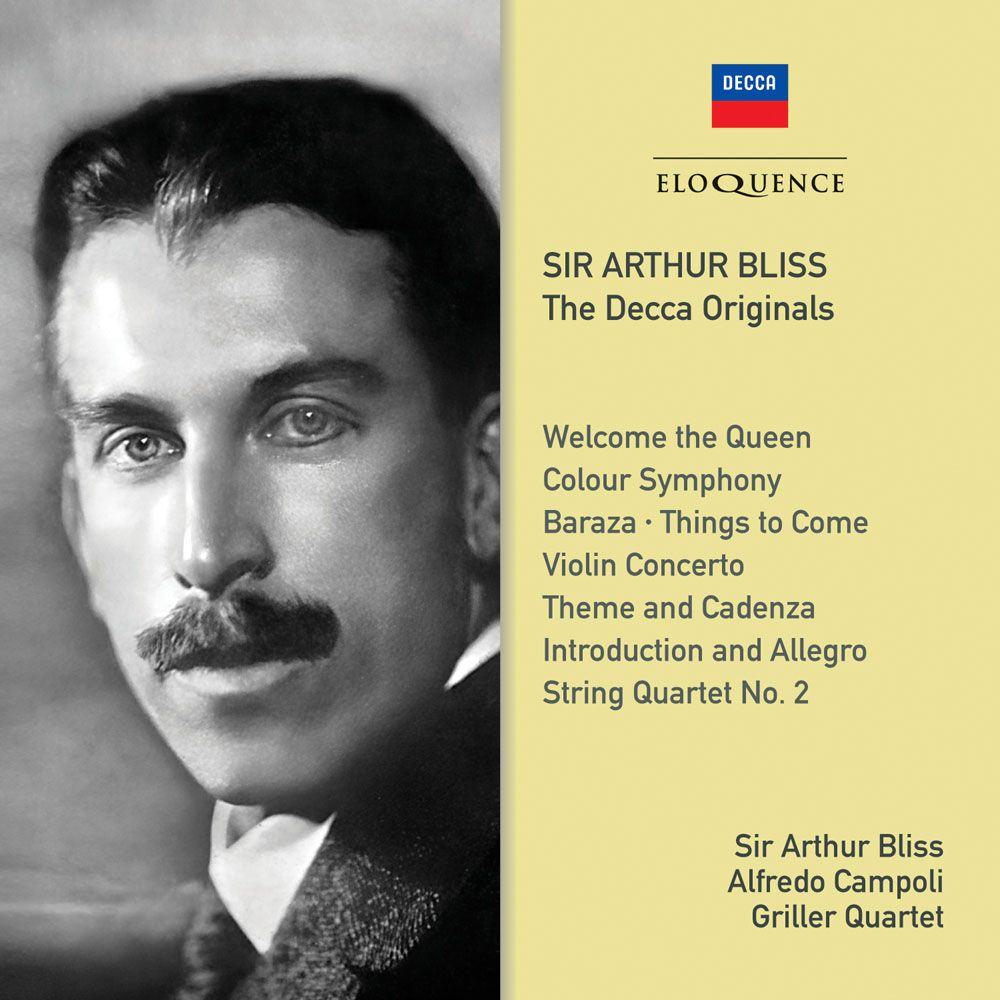Bliss: The Decca Originals: a new collection of Decca recordings of Bliss’s music, including tracks previously unreleased on Decca CD as well as the complete version of the Violin Concerto with Alfredo Campoli.
The career of Arthur Bliss was launched in London in the 1920s with provocative ensemble pieces such as Rout, but it was established by the Colour Symphony which Sir Edward Elgar invited him to write for the Three Choirs Festival. Bliss gradually became an establishment figure, appointed Master of the Queen’s Music in 1953 and a fluent maker of music celebrating Englishness (such as Welcome the Queen, 1954) at a time when notions of national identity were coming under scrutiny as never before.
However, Bliss always retained something of the dashing provocateur about him, and his best music often had a terse and anguished quality – such as the Introduction and Allegro which filled out the first LP of the Colour Symphony, or the score he wrote for the H.G. Wells film, Things to Come, or the Second String Quartet. These premiere, composer-conducted and -supervised recordings from the 1950s are reissued here, along with a genuine rarity, Baraza: a concertante movement for piano and orchestra crafted from the film music he wrote for Men of Two Worlds.
In 1955 Bliss responded to a BBC commission with his most accomplished work in the concerto genre, written with the violinist Alfredo Campoli in mind. The premiere enjoyed a great success, and a Decca recording soon followed. However, the composer remained dissatisfied by the length of the concerto, and having recorded it complete, ensured that certain cuts were made for the first release. This missing material has been restored and the whole recording newly remastered, presenting on CD for the first time the complete score of the Concerto as its composer and first soloist recorded it.
SIR ARTHUR BLISS (1891–1975)
CD 1
1 Welcome the Queen, F.95
2–7 Things to Come, F.131*
8–11 A Colour Symphony, F.106
12 Introduction and Allegro, F.117
London Symphony Orchestra
Sir Arthur Bliss
13 Baraza (from ‘Men of Two Worlds’, F.121)
Eileen Joyce, piano
Men’s Chorus
National Symphony Orchestra
Muir Mathieson
CD 2
1–3 Violin Concerto, F.111°
4 Theme and cadenza for Violin and Orchestra, F.120
Alfredo Campoli, violin
London Philharmonic Orchestra
Sir Arthur Bliss
5–8 String Quartet No. 2 in F minor, F.26*
Griller Quartet
*FIRST CD RELEASE ON DECCA
°FIRST CD RELEASE OF ORIGINAL VERSION ON DECCA
Recording Producers: Victor Olof (Baraza); Christopher Whelan (Welcome the Queen, Things to Come); John Culshaw (Violin Concerto); unidentified (A Colour Symphony; Introduction and Allegro, String Quartet No. 2)
Recording Engineers: Kenneth Wilkinson (Baraza, Violin Concerto); Kenneth Wilkinson, Ken Cress (Welcome the Queen, Things to Come); unidentified (A Colour Symphony; Introduction and Allegro, String Quartet No. 2)
Recording Engineers: Kenneth Wilkinson (Baraza, Violin Concerto); Kenneth Wilkinson, Ken Cress (Welcome the Queen, Things to Come); unidentified (A Colour Symphony; Introduction and Allegro, String Quartet No. 2)
Recording Locations: Kingsway Hall, London, UK, 5 February 1946 (Baraza), 9–11 November 1955 (Violin Concerto), 23–24 November 1955 (A Colour Symphony, Introduction and Allegro), 30 April 1957 (Things to
Come); Walthamstow Assembly Hall, London, UK, 21 May 1957 (Welcome the Queen); Decca Studios, West Hampstead, London, UK, 29 September – 25 October 1950 (String Quartet No. 2)
Remastering Engineer: Chris Bernauer
Original Decca Releases: K1174 (Baraza, April 1946); SDD 255 (Welcome the Queen; Things to Come, November 1970, originally released on RCA: SB2026, March 1959); LXT 5170 (A Colour Symphony; Introduction and Allegro, June 1956); ACL 317 (Violin Concerto – original version, May 1969); LXT 5166 (Theme and Cadenza, April 1956); LX 3038 (String Quartet No. 2, March 1951)
‘His music adds to any royal scene and makes us lift our hearts the higher… Excellent stuff, and given us in rich and excellent recording.’ Gramophone, July 1954 (Welcome the Queen)
‘[The Second Quartet] is superbly written and successfully achieves its intention. The music suits the character of the Grillers’ playing … The recording is rather light on bass, but it accommodates successfully the fierce sforzandi in which the work abounds.’ The Record Guide, 1955
‘Campoli … copes with the very difficult solo part as if it were child’s play.’ Humphrey Searle, The Gramophone Record Review, June 1956 (Violin Concerto)
‘Heard today, in this full-blooded performance under the composer, one is conscious of his disciplined exuberance at 30 years old.’ Gramophone, August 1956 (Colour Symphony)

